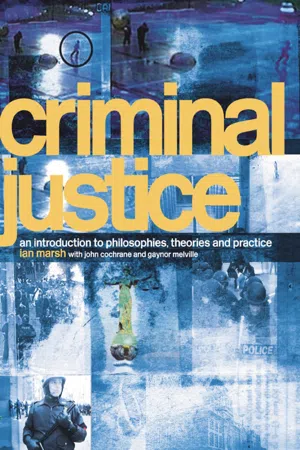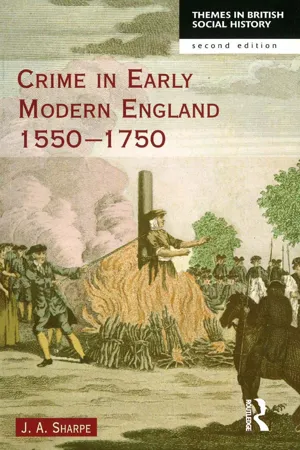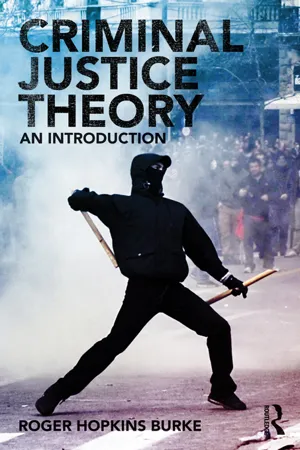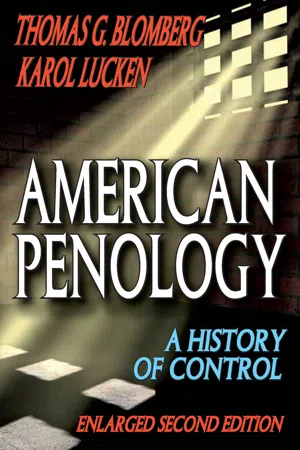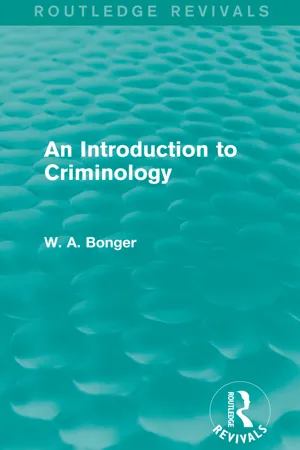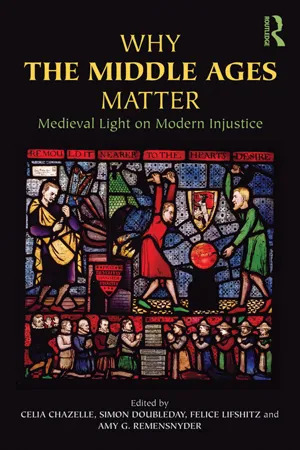History
Crime and Punishment in Early Modern England
Crime and Punishment in Early Modern England refers to the legal and social systems of justice during the 16th to 18th centuries. It involved a range of punishments for various crimes, including fines, public shaming, and corporal punishment. The period saw the emergence of more formalized legal processes and the development of prisons as a means of punishment and rehabilitation.
Written by Perlego with AI-assistance
Related key terms
9 Key excerpts on "Crime and Punishment in Early Modern England"
- eBook - ePub
Criminal Justice
An Introduction to Philosophies, Theories and Practice
- Ian Marsh, John Cochrane, Gaynor Melville(Authors)
- 2004(Publication Date)
- Routledge(Publisher)
Albion’s Fatal Tree: Crime and Society in the 18th Century, Harmondsworth: Penguin. A classic historical analysis of the use of the criminal law as an ideological weapon. It focuses on the manipulation of the ‘Bloody Code’ by ‘an astute ruling class in their own interests’. Hay’s essay ‘Property, Authority and the Criminal Law’ is particularly recommended as a study of eighteenth-century capital punishment.Morris, N. and Rothman, D. J. (1998) The Oxford History of the Prison: The Practice of Punishment in Western Society, Oxford: Oxford University Press. This provides a comprehensive coverage of the history of incarceration from ancient times to the modern day. Examples are drawn from Britain, continental Europe and the United States.Sharpe, J. A. (1999) Crime in Early Modern England, 1550–1750, 2nd edn, Harlow: Longman. An excellent, wide-ranging analysis of crime, criminality and punishment in the early modern period. Especially useful are chapters 3 and 4 on measuring and controlling crime. Chapter 5 is a valuable study of offenders which includes a useful section on gender. Other areas covered include popular attitudes to criminality and elite perceptions of crime and threat.Passage contains an image
4 Victimology
Introduction
It goes without saying that any criminal justice system will be preoccupied with the behaviour, the punishment and the rehabilitation of the criminal. The behaviour of the criminal has been the particular focus of criminology, although work in this area overlaps with a number of academic disciplines, including sociology and psychology. As regards the punishment of offenders, the different aims of and justifications for punishment, whether they be essentially retributive or reformative, have sparked continued philosophical debate. However, this academic obsession with the criminal has been at the expense of detailed consideration of the victim. Indeed, the victim often seems to be added to criminological theorising and debate merely out of politeness or political correctness. The consequences of this omission are important. The lack of academic interest has left the victim in the dark – a situation that has led to a good deal of public policy making not being informed by the needs, wants and status of the victim within the criminal justice system. - eBook - ePub
- James A Sharpe(Author)
- 2014(Publication Date)
- Routledge(Publisher)
CHAPTER EIGHTContinuity and Change in Crime and Punishment 1550–1750
In the previous chapters we have ranged freely over a number of areas, and have demonstrated, if nothing else, the variety of approaches that can be employed in studying the history of crime, and the multiplicity of issues involved in the subject. The point has now come for pulling these various threads together, and attempting to understand the general developments and problems relevant to the study of crime in our period. These developments and problems are fairly numerous, and the avenues towards understanding them correspondingly diverse. There is, nevertheless, one essential central theme: that of the possible connections between patterns of crime, patterns of punishment, the attitudes of ruling groups to such matters, and broader socio-economic change. After all, a general consensus suggests that such connections exist: thus a student of crime in Victorian and Edwardian Britain, for example, could claim that‘it has become one of the more widely accepted axioms of our age that an increasing crime rate is the invariable price of material progress’.1 Commentators on earlier periods have, in general, been equally convinced of the presence of such links. Hence the author of a general work on crime in early modern Europe informs us that ‘although crime is usually seen as an index of social distress, it can also be appreciated as an index of social development’, claims that the pattern of European theft, if drawn up, would correlate in time and geography with economic development, and suggests that within the timespan he covers Europe witnessed ‘the emergence of new forms of criminality that reflected the ongoing transition to industrial life’.2 - eBook - ePub
Criminal Justice Theory
An Introduction
- Roger Hopkins Burke(Author)
- 2013(Publication Date)
- Routledge(Publisher)
6 Punishment in Modern SocietyThis chapter discusses the philosophy and theory of punishment in modern societies and locates this debate in the context of the four models of criminal justice development that provide the theoretical underpinnings of this text. It is important to remember that all too often punishment is considered to be a distinct and separate entity from the understanding of penology but it is impossible to legitimately understand one without the other, for imprisonment is, next to capital punishment, the harshest and certainly one of the most commonly used sentences. Without the acknowledgement of penal realities, justifications for punishment become mere intellectual debate. Trying to make sense of familiar concepts such as ‘making the punishment fit the crime’, is not strictly a theoretical question and these are not just philosophical matters of concern to academia. These questions have great practical relevance within the criminal justice process generally and the penal system specifically. By bringing the two together, locating penal trends in theory, and grounding theory in policy, the totality becomes greater than the sum of its parts.According to an old Muslim legend, there was once a rich king who left his servant in charge of his kingdom and in receipt of his riches, while he went on a long journey. Upon returning to his kingdom he found to his dismay that his servant had stolen some of his treasures. The rich king took the servant in front of the judge for sentencing. The judge ordered that both the servant and the king should be punished; the servant because he had broken the law, and the king because, by leaving such a great temptation in the hands of a person with so few possessions and possibly weak character (both realities which the king should have been able to assess), the king was in fact causing the man harm (Ellis and Ellis, 1989). - eBook - ePub
American Penology
A History of Control
- Thomas G. Blomberg(Author)
- 2017(Publication Date)
- Routledge(Publisher)
Early colonial settlers brought with them only a basic understanding of English common law. The English common law system established the practices of oral testimony, a jury of peers, and the classification of offenses. However, be cause of America's geographic separation from England, colonists were only required to “establish laws not contrary to those of England.” Consequently, they were free to discard those elements of English law with which they did not agree. For example, criminal codes in colonial America were generally more lenient than in England, particularly with regard to capital punishment. There were differences in the laws between colonies as well. Colonies developed their own ideas about crime and punishment based on their specific religious beliefs and immediate surroundings. For example, Pennsylvania and New England shared a preoccupation with moral offenses, while South Carolina tended to ignore them (Kann, 2005).Though colonies functioned as “little worlds on their own” (Friedman, 1993), a discernable pattern to the ideas and practices surrounding crime and punishment still could be observed. For instance, in all colonies, public and physical punishments of various types were the norm. Indeed, these two dominant attributes are what set colonial punishment apart from punishments imposed in every other period of American history. This chapter describes these crime and punishment patterns in more detail and the histori cal contingencies that shape these patterns.Life in the Colonies
Colonial society was organized around the three primary institutions of community, church, and family. Colonists maintained rigid ideas about the importance of these institutions because they provided the only social safety net and means of social order. Community cohesion and order were made possible by worshipping at the same church, marrying neighbors, and the necessary pooling and sharing of resources (Rothman, 1971). Community cohesion and order were also facilitated by the establishment of small, closely knit communities. Even as late as 1760, there were only seven cities in the colonies with more than three thousand inhabitants (Preyer, 1982). Without question, it was an excessively communal life, which meant that nothing escaped the watchful eye of the collective (Friedman, 1993). Colonial society was “well stocked with moral monitors who did not miss much in the goldfish bowl existence of daily life” (Thompson, 1986). - eBook - ePub
- Barry Godfrey, Graeme Dunstall(Authors)
- 2013(Publication Date)
- Willan(Publisher)
Chapter 3
Explaining the history of punishment
John PrattAfter inviting me to give a seminar on my work to a local criminology society meeting, a colleague later introduced me to the audience as ‘an armchair academic’. In their mind, because I had been engaged in historical research, it was as if what I was doing was some sort of esoteric but largely irrelevant luxury. Happily, I am certain that this depressing view of the parameters and possibilities of criminological research is idiosyncratic to that person rather than normative of the discipline as a whole. Indeed, as I show in this chapter, the history of punishment has demonstrated an exhilarating expansion and fortitude over the last three decades or so. Not that it was always like this, though. There had been a dearth of historical scholarship before then. Why this might have been so, how and in what ways the history of punishment has become such a dynamic subject since that point, and how our understanding of the purposes and nature of historical inquiry have changed will be the main themes of this chapter.The contribution of Radzinowicz
Sir Leon Radzinowicz (1948: ix) began the preface to what ultimately became his monumental five volumed History of English Criminal Law with the statement that:Lord Macauley’s generalisation that the history of England is the history of progress is as true of the criminal law of this country as of the other social institutions of which it is a part. Child of the Common Law, nourished and moulded by statute, the criminal law of England has always been sensitive to the needs and aspirations of the English people, and it has continually changed under the impact of the predominant opinion of the day. - eBook - ePub
Foucault - The Key Ideas
Foucault on philosophy, power, and the sociology of knowledge: a concise introduction
- Paul Oliver(Author)
- 2010(Publication Date)
- Teach Yourself(Publisher)
There was also a changing sense of morality in society. Offences were seen rather less as crimes against government, authority or those in power, but rather more against the nature of society itself. A criminal offence was a crime against other citizens, against one’s neighbours or community. Crime was a social offence and it was necessary for the punishment to be viewed as appropriate to the offence. There thus developed a social morality where different types of crime were viewed as more unethical than others.InsightTowards the end of the eighteenth century crimes began to be evaluated in terms of the extent of their negative effects on society, and the extent to which they reduced the cohesion of society. For instance, one element of such social cohesion was that people should work hard and gain from the proceeds of that hard work. Theft was seen to be serious because it undermined the advantages of hard work.In the new social context of crime, citizens demanded a form of legal fairness in the evaluation of the likely guilt or innocence of someone. If this was not so, then an innocent person could easily be found guilty of a crime they did not commit. New rules and standards for the assessment of evidence were developed in order to be able to judge someone objectively and fairly. We are familiar in modern times with the way in which certain types of crime are grouped together and attract a comparable type of punishment.So used are we to the logic of this type of judicial and legal system, that we perhaps take it for granted. Yet it was in the nineteenth century that we began to see the emergence of this type of system. The notion that ‘the punishment should fit the crime’ began to emerge as a rational system.Foucault emphasized that ‘detention and imprisonment do not form part of the European penal system before the great reforms of the years 1780–1820’ (Rabinow, Michel Foucault: Ethics , p. 23 - eBook - ePub
- Tim Newburn(Author)
- 2017(Publication Date)
- Routledge(Publisher)
Thus, on the one hand Gurr’s data suggest that the nineteenth century saw a sustained drop in levels of violence and, indeed, there is other historical evidence which suggests that violence was higher in previous centuries (Leyton, 1995). On the other hand, Taylor suggests that the police deliberately left many murders and suspicious deaths uninvestigated in order to limit both the number and the cost of prosecutions. Possible further light is thrown on this issue by data on riot and other forms of disturbance during the course of the nineteenth century. There is historical evidence that suggests that although major disturbances continued on a fairly regular basis well into the nineteenth century – particularly in labour disputes and during political demonstrations – there appears to have been ‘a definite trend away from violence and public disorder’ in the period between 1835 and 1860 (Philips, 1978: 274). Almost certainly, therefore, the Victorians were in large part correct in their portrayal of the era as one of relative orderliness. How any era is understood, however, depends upon more than official estimates of levels of crime. Thus:There was more to Victorian perceptions of the orderliness of their society than can be expressed in criminal statistics. In part, one is dealing with attitudes and beliefs which represented a particular moment in social and political development. One crucial perspective for Victorians was that whatever the dangers and difficulties of the past, Britain had escaped the revolutionary upheavals which had affected other nations.(Stevenson, 1979: 298)Perceptions of crimeAs we saw earlier in this chapter, the emergence of what we might understand as the ‘modern’ criminal justice system – essentially a bureaucratic extension and expression of the nation state – came into being during the eighteenth and nineteenth centuries. Prior to that, ‘crime control’ was much more a localised matter. The transition toward a centralised state system of justice reflects, in part, changing perceptions of crime or, more accurately, changing perceptions of deviance and, within this, the emergence of something akin to our contemporary notion of ‘crime’.In the seventeenth century and earlier, perceptions of crime were closely tied to ideas of sin and how best it might be suppressed. In other words, crime was not yet a secular term, but was closely bound up with religious morality and the power of the Church. During the eighteenth century this situation gradually changed and it is argued, particularly by radical historians, that ideas of crime and sin rooted in religious teaching were gradually replaced by a set of secular concerns, the most fundamental of which were the need and desire to protect private property. This transition should not be exaggerated, however, for religious ideas and organisations continued to exert a powerful influence throughout the eighteenth and nineteenth centuries – not least through reform programmes aimed at the drunk, the idle and the disorderly. - eBook - ePub
- W. A. Bonger(Author)
- 2015(Publication Date)
- Routledge(Publisher)
Symbolik der tnenschlichen Gestalt (1853), C. G. Carus gives a survey of the history of the science which treats of the connexion between outward appearance and inner qualities in man (p. 40 et seq.).9 The Eighteenth Century Until the French Revolution
(i) The opposition to the existing criminal law and criminal jurisprudence.
Criminal law in the latter part of the Middle Ages, the sixteenth, seventeenth, and the greater part of the eighteenth centuries was exclusively intended to serve as a deterrent and attempted to achieve this purpose by means of the most cruel punishments. The death penalty, in its most barbaric variations (generally preceded by some sharp form of torture, e.g. the rack!) and corporal punishments were quite usual forms; the idea of general prevention of crime being the chief consideration. The person of the criminal was not recognized; he was an object serving as a 'terrible example' to others, and the purely objective element of social danger inherent in the offence was the final consideration. Penallaws were vague (analogy in criminal law), and their formulation ambiguous.1 The procedure in criminal cases bore a similar character. It was inquisitorial, and the accused was looked upon as a mere object of investigation; it was conducted in secret and chiefly according to documentary evidence. The law of evidence was highly arbitrary, and confession was considered to be the best form of proof; hence the torture-bench.1 Vide, amongst other works, C. G. Wichmann, Beschouwingen over de historische grondslagen der tegenwoordige vorming van het strafbegrip (1912), (Reflections on the historic foundations of the present reformist movement in the conception of punishment), Chapter II, particularly p. 60 et seq.The grand opposition movement of the third estate against the Ancien Régime also drew criminal law and criminal jurisprudence into its scope. The Aufklärung began to shine in this field too. The Rights of Man were, henceforth, also to apply to the criminal.2 Montesquieu (1689-1755) opened the attack, with his Esprit des Lois (1748), in which he entered the field against the arbitrariness and severity of the punishments, and their undue frequency.3 The voice of humanity was heard for the first time. Rousseau (1712-78) also joined in the opposition to the cruel treatment meted out to the criminal. Voltaire (1694-1778) enters the lists in 1762, on behalf of the innocently condemned and executed Jean Calas, and becomes one of the doughtiest fighters against the arbitrariness of criminal jurisprudence of his day.4 In 1777 a competition was held by the Oekonomische Gesellschaft at Bern, for a plan of a better criminal legislature. One of the competitors was J. P. Marat (1744-93), with his Plan de législation criminelle (1780),5 while the work of J. P. Brissot de Warville (1754-93)3 Théorie des lois criminelles - eBook - ePub
Why the Middle Ages Matter
Medieval Light on Modern Injustice
- Celia Chazelle, Simon Doubleday, Felice Lifshitz, Amy G. Remensnyder(Authors)
- 2012(Publication Date)
- Routledge(Publisher)
5Early medieval practices underscore the value of community and reparative justice for responding to nonviolent offenders in cities like Camden and, further, point toward initiatives that could provide similar benefits when dealing with violent offenders. Among the advantages of looking at modern penal policies through the lens of early medieval justice, one is that it reveals the particular importance of family and social networks to community wellbeing.Early Medieval JusticeThe best known medieval European judicial punishments are no doubt the spectacularly dramatic, painful torments seen in Hollywood films and Far Side cartoons: bodies broken on wheels and hanging from public gallows, beheadings, burnings, tortures like the thumbscrew and the rack. Foucault famously begins Discipline and Punish with a lurid account of the torture and drawing and quartering of Damiens, the would-be regicide (king-killer), in Paris in 1757. For Foucault, this scene harked back to a medieval emphasis on punishing the body, an approach to crime for which, he asserts, modernity has substituted the equally coercive punishment of prison. We now realize physical torture is still with us; but most Americans would agree that prisons illustrate our modernity, and most – unlike Foucault – believe these institutions are far more humane than any penalties of the middle ages.Medieval records, however, reveal a more nuanced situation. The majority of the sources for studying medieval penalties date from the twelfth and later centuries. The evidence is sparser for the early middle ages, yet people then, too, were familiar with a host of painful practices. Early medieval lawcodes enjoin execution for offenses ranging from homicide to adultery to relapsing into paganism. Narrative sources tell of kings and aristocrats who condemned enemies to exile or death, and of lords who commanded that dependents be branded, blinded, or lose noses or ears. Courts ordered torture and ordeals – such as trial by fire, where the suspect walked on burning coals, or trial by water where he or she picked an object out of boiling water. Skeletons unearthed from burial grounds show the effects of decapitation, amputation, and limbs bound possibly for hanging.6 Furthermore, while imprisonment was unusual, it was not absent, and again the experience must have been decidedly unpleasant. Nobles who rebelled against kings, priests who disobeyed bishops, and slaves or serfs (people of servile or unfree status) who tried to escape were sometimes confined in monasteries; some religious houses had a special room called a carcer
Learn about this page
Index pages curate the most relevant extracts from our library of academic textbooks. They’ve been created using an in-house natural language model (NLM), each adding context and meaning to key research topics.
